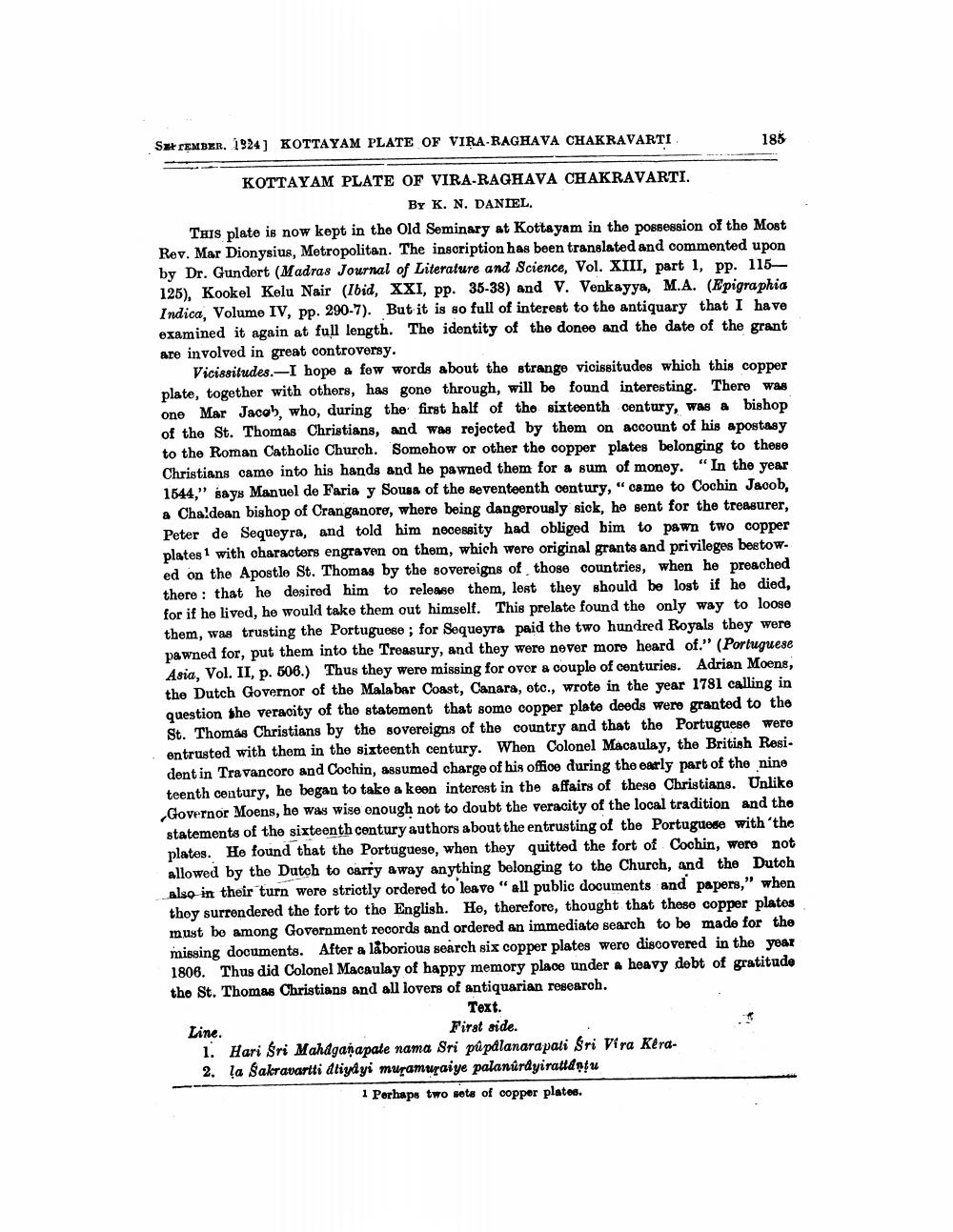________________
S**TEMBER. 1924) KOTTAYAM PLATE OF VIRA-RAGHAVA CHAKRAVARTI
185
KOTTAYAM PLATE OF VIRA-RAGHAVA CHAKRAVARTI.
BY K. N. DANIEL. This plate is now kept in the Old Seminary at Kottayam in the possession of the Most Rev. Mar Dionysius, Metropolitan. The inscription has been translated and commented upon by Dr. Gundert (Madras Journal of Literature and Science, Vol. XIII, part 1, pp. 115 125), Kookel Kelu Nair (Ibid, XXI, pp. 35-38) and V. Venkayya, M.A. (Epigraphia Indica, Volume IV, pp. 290-7). But it is so full of interest to the antiquary that I have examined it again at full length. The identity of the donee and the date of the grant are involved in great controversy.
Vicissitudes. I hope a few words about the strange vicissitudes which this copper plate, together with others, has gone through, will be found interesting. There was one Mar Jacob, who, during the first half of the sixteenth century, was a bishop of the St. Thomas Christians, and was rejected by them on account of his apostasy to the Roman Catholic Church. Somehow or other the copper plates belonging to these Christians came into his hands and he pawned them for a sum of money. "In the year 1544," says Manuel de Faria y Sousa of the seventeenth century," came to Cochin Jacob, a Chaldean bishop of Cranganore, where being dangerously sick, he sent for the treasurer, Peter de Sequeyra, and told him nocessity had obliged bim to pawn two copper plates1 with characters engraven on them, which were original grants and privileges bestowed on the Apostle St. Thomas by the sovereigns of those countries, when he preached there : that he desired him to release them, lest they should be lost if he died, for if he lived, he would take them out himself. This prelate found the only way to loose them, was trusting the Portuguese ; for Sequeyra paid the two hundred Royals they were vawned for, put them into the Treasury, and they were never more heard of." (Portuguese Asia, Vol. II, p. 506.) Thus they were missing for over a couple of conturies. Adrian Moens, the Dutch Governor of the Malabar Coast, Canara, etc., wrote in the year 1781 calling in question the veracity of the statement that somo copper plate deeds were granted to the St. Thomas Christians by the sovereigns of the country and that the Portuguese were entrusted with them in the sixteenth century. When Colonel Macaulay, the British Resident in Travancoro and Cochin, assumed charge of his office during the early part of the nine teenth century, he began to take a keen interest in the affairs of these Christians. Unlike Governor Moens, he way wise onough not to doubt the veracity of the local tradition and the statements of the sixteenth century authors about the entrusting of the Portuguese with 'the plates. He found that the Portuguese, when they quitted the fort of Cochin, were not allowed by the Dutch to carry away anything belonging to the Church, and the Dutch also in their turn were strictly ordered to leave "all public documents and papers," when thoy surrendered the fort to the English. He, therefore, thought that these copper plates must be among Government records and ordered an immediate search to be made for the missing documents. After a låborious search six copper plates wero discovered in the year 1806. Thus did Colonel Macaulay of happy memory place under a heavy debt of gratitude the St. Thomas Christians and all lovers of antiquarian research.
Text. Line.
First side. 1. Hari Sri Mahagańapale nama Sri pûpdlanarapati Sri Vira Kera2. !a Sakravartti dtiyayi muramuraiye palanürdyirattantu
1 Perhaps two sets of copper plates.




